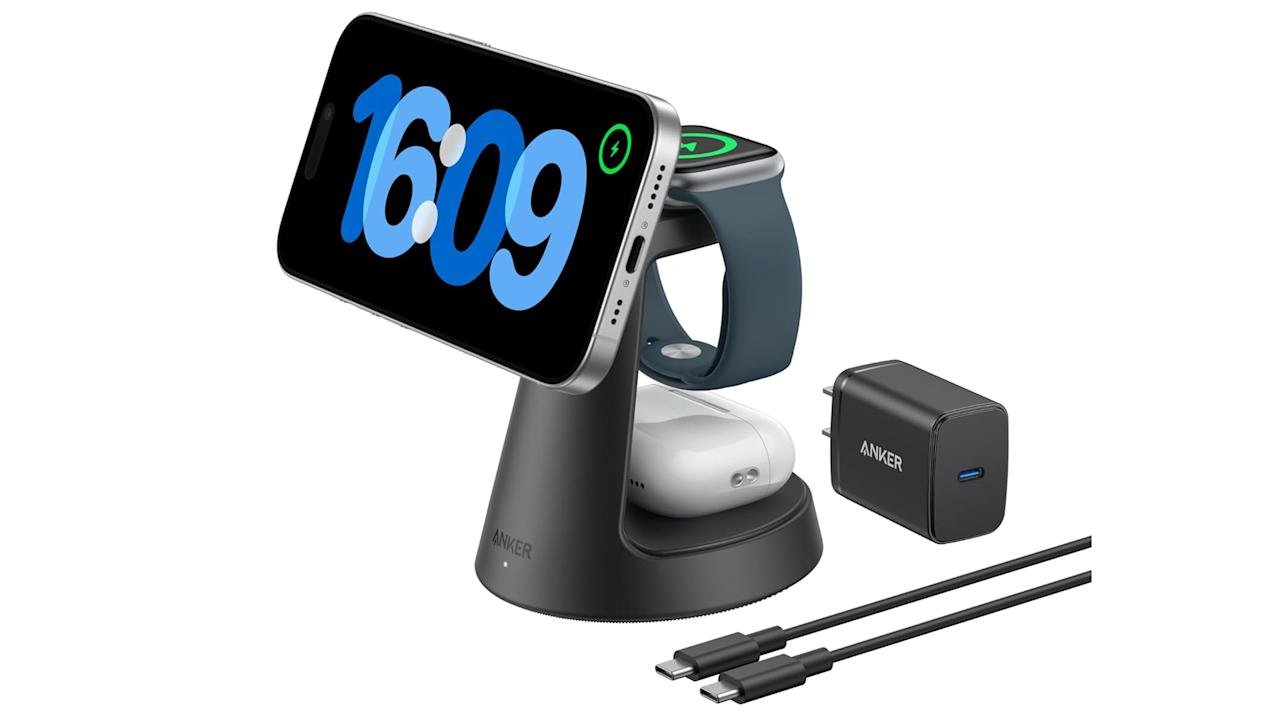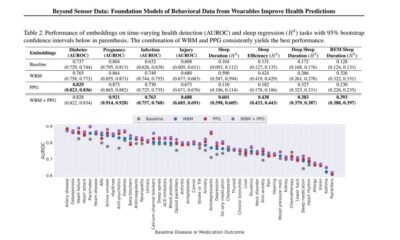AI Insights
Get up to 35 percent off Anker wireless chargers ahead of Labor Day

Anker makes some of our favorite charging gear, and now you can save on a bunch of wireless power accessories from the brand. Whether you’re going back to school soon or want a new charging station that can power up a few devices at once, there are discounts here worth considering. One of the best is this 3-in-1 MagSafe charging station, on sale for a record low price of $63. The Qi2-certified charger wirelessly charges your compatible iPhone, Apple Watch, and AirPods on one compact and convenient dock. Qi2 boasts 15W of power, so you can take advantage of fast charging on compatible devices.
This means the station can charge an iPhone 16 Pro Max to 20 percent in just 20 minutes and an Apple Watch Series 10 from zero to 100 percent in just over an hour. The magnetic stand for your iPhone is adjustable with 45 degrees of vertical rotation and 360 degrees of horizontal rotation, so you can always find the perfect angle for your phone while charging.
Being able to wirelessly charge these three daily devices at once might remind you of Apple’s wireless charging pad that never was, but Anker’s 3-in-1 charging station offers an elegant solution. We tend to like Anker’s charging products, and we’ve found they make some of the best charging stations on the market.
Anker’s products can be a bit pricey, though, which is why the best time to pick them up is during these sales. The company actually has a slew of its charging products on sale right now. Its 3-in-1 wireless charging cube is 31 percent off right now and down to $104. If you’re a Prime member and have a Qi2-compatible iPhone, then you might also look at Anker’s simple Qi2 charging pad, which is 35 percent off for a two-pack right now.
Follow @EngadgetDeals on X for the latest tech deals and buying advice.
AI Insights
AI drug companies are struggling—but don’t blame the AI

Moonshot hopes of artificial intelligence being used to expedite the development of drugs are coming back down to earth.
More than $18 billion has flooded into more than 200 biotechnology companies touting AI to expedite development, with 75 drugs or vaccines entering clinical trials, according to Boston Consulting Group. Now, investor confidence—and funding—is starting to waver.
In 2021, venture capital investment in AI drug companies reached an apex with more than 40 deals being made worth about $1.8 billion. This year, there have been fewer than 20 deals worth about half of that peak sum, the Financial Times reported, citing data from Pitchbook.
Some existing companies have struggled in the face of challenges. In May, biotech company Recursion tabled three of its prospective drugs in a cost-cutting effort following a merger with Exscientia, a similar biotech firm, last year. Fortune previously reported that none of Recursion’s discovered AI-compounds have reached the market as approved drugs. After a major restructuring in December 2024, biotech company BenevolentAI delisted from the Euronext Amsterdam stock exchange in March before merging with Osaka Holdings.
A Recursion spokesperson told Fortune the decision to shelve the drugs was “data-driven” and a planned outcome of its merger with Exscientia.
“Our industry’s 90% failure rate is not acceptable when patients are waiting, and we believe approaches like ours that integrate cutting-edge tools and technologies will be best positioned for long-term success,” the spokesperson said in a statement.
BenevolentAI did not respond to a request for comment.
The struggles of the industry coincide with a broader conversation around the failure of generative AI to deliver more quickly on its lofty promises of productivity and efficiency. An MIT report last month found 95% of generative AI pilots at companies failed to accelerate revenue. A U.S. Census Bureau survey this month found AI adoption in large U.S. companies has declined from its 14% peak earlier this year to 12% as of August.
But the AI technology used to help develop drugs is far different than those from large language models used in most workplace initiatives and should therefore not be held to the same standards, according to Scott Schoenhaus, managing director and equity research analyst for KeyBanc Capital Markets Inc. Instead, the industry faces its own set of challenges.
“No matter how much data you have, human biology is still a mystery,” Schoenhaus told Fortune.
Macro and political factors drying up AI drug development funding
At the crux of the slowed funding and slower development results may not be the limitations of the technology itself, but rather a slew of broader factors, Schoenhaus said.
“Everyone acknowledges the funding environment has dried up,” he said. “The biotech market is heavily influenced by low interest rates. Lower interest rates equals more funding coming into biotechs, which is why we’re seeing funding for biotech at record lows over the last several years, because interest rates have remained elevated.”
It wasn’t always this way. Leveraging AI in drug development is not only thanks to growing access to semiconductor chips, but also how technology has allowed for quick and now cheap ways of mapping the entire human genome. In 2001, it cost more than $100 million to map the human genome. Two decades later, that undertaking cost about $1,000.
Beyond having the pandemic to thank for next-to-nothing interest rates in 2021, COVID also expedited partnerships between AI drug development start ups and Big Pharma companies. In early 2022 biotechnology startup AbCellera and Eli Lilly got emergency FDA approval for an antibody used in the early COVID vaccines, a tangible example of how the tech could be used to aid in drug discoveries.
But since then, there have been other industry hurdles, Schoenhaus said, including Big Pharma cutting back on research and development costs amid slowing demand, as well as uncertainty surrounding whether President Donald Trump would impose a tariff on pharmaceuticals as the U.S. and European Union tussled over a trade deal. Trump signed a memo this week threatening to ban direct-to-consumer advertising for prescription medications, theoretically driving down pharma revenues.
Limitations of AI
That’s not to say there haven’t been technological hiccups in the industry.
“There is scrutiny around the technology themselves,” Schoenhaus said. “Everyone’s waiting for these readouts to prove that.”
The next 12 months of emerging data from AI drug development startups will be critical in determining how successful these companies stand to be, Schoenhaus said. Some of the results so far have been mixed. For example, Recursion released data from a mid-stage clinical trial of a drug to treat a neurovascular condition in September last year, finding the drug was safe but that there was little evidence of how effective it was. Company shares fell double digits following the announcement.
These companies are also limited by how they’re able to leverage AI. The drug development process is one that takes 10 years and is intentionally bottlenecked to ensure the safety and efficacy of the drugs in question, according to according to David Siderovski, chair of University of North Texas Health Science Center’s Department of Pharmacology & Neuroscience, who has previously worked with AI drug development companies in the private sector. Biotechnology companies using AI to make these processes more efficient are usually only tackling one small part of this bottleneck, such as being able to screen and identify a drug-like molecule faster than previously.
“There are so many stages that have to be jumped over before you can actually declare the [European Medicines Agency], or the FDA, or Health Canada, whoever it is, will designate this as a safe, approved drug to be marketed to patients out in the world,” Siderovski told Fortune. “That one early bottleneck of auditioning compounds is not the be-all and end-all of satisfying shareholders by announcing, ‘We have approval for this compound as a drug.’”
Smaller companies in the sector have also made a concerted effort to partner less with Big Pharma companies, preferring instead to build their own pipelines, even if it means no longer having access to the franchise resources of industry giants.
“They want to be able to pursue their technology and show the validation of their platform sooner than later,” Schoenhaus said. “They’re not going to wait around for large pharma to pursue a partnered molecule. They’d rather just do it themselves and say, ‘Hey, look, our technology platform works.’”
Schoenhaus sees this strategy as a way for companies looking to prove themselves by perfecting the use of AI to better understand the slippery, mysterious, and still greatly unknown frontier of human biology.
“It’s just a very much more complex application of AI,” he said, “hence why I think we are still seeing these companies focus on their own internal pipelines so that they can really, squarely focus their resources on trying to better their technology.”
AI Insights
Companies Rehire Human Workers to Fix Artificial Intelligence Generated Content After Mass Layoffs

| IN A NUTSHELL |
|
The integration of artificial intelligence (AI) into workplaces has become a prevalent trend, often at the expense of human employees. This shift, while aiming to optimize efficiency and cut costs, has exposed the limitations of relying solely on AI. As companies increasingly replace human roles with AI, they encounter unforeseen challenges that highlight the irreplaceable value of human expertise. The journey reveals the complex dynamics between technology adoption and workforce sustainability, raising important questions about the future of work and the role of AI in it.
AI’s Shortcomings Lead to Reemployment
While AI promises to revolutionize industries by automating tasks, its execution often falls short, leading companies to reconsider their human workforce. AI-generated outputs frequently lack the nuance and precision that human creativity and expertise bring. For instance, textual content may appear repetitive, designs might lack clarity, and AI-generated code could result in unstable applications. These deficiencies compel businesses to turn back to the very employees they had previously let go.
Lisa Carstens, an independent illustrator and designer, experienced firsthand the limitations of AI. Based in Spain, Carstens found herself rehired to fix AI-generated visuals that were, at best, superficially appealing and, at worst, unusable. She noted that many companies assumed AI could operate without human intervention, only to realize the opposite.
“There are people who understand AI’s imperfections and those who become frustrated when it doesn’t perform as expected,” Carstens explains, highlighting the delicate balance freelancers must maintain when rectifying AI’s mistakes.
The Emergence of a New Freelance Economy
AI has inadvertently given rise to a new type of freelance work focused on improving AI-generated content. Developers like Harsh Kumar, based in India, have seen a resurgence in demand for their skills as AI’s limitations become apparent. Clients who invested heavily in AI coding tools often found the results to be unsatisfactory, leading them to seek human expertise to salvage projects.
Kumar echoes the sentiment that AI can enhance productivity but cannot entirely replace human input. “Humans will remain essential for long-term projects,” he asserts, emphasizing that AI, created by humans, still requires human oversight. While work is plentiful, the nature of assignments has evolved, with a focus on refining and iterating upon AI’s initial attempts at content creation.
The Challenges of Human-AI Collaboration
The dynamic between AI and human workers is not without its challenges. While companies that over-relied on AI often seek to rehire their former employees, they also attempt to reduce compensation for these roles. The justification is that the work now involves refining existing AI-generated content rather than creating it from scratch.
This shift highlights a more integrated human-machine collaboration where both entities contribute uniquely to the final product. However, it also raises questions about fair compensation and the value of human expertise in a world increasingly influenced by AI. As companies attempt to balance cost-cutting with quality assurance, the debate over appropriate remuneration for freelance revisions of AI work continues.
AI in the Workplace: A Double-Edged Sword
While AI offers numerous advantages, such as increased efficiency and cost savings, it also presents significant challenges. Businesses must navigate the delicate balance between adopting AI technologies and maintaining a skilled human workforce. The experiences of freelancers like Carstens and Kumar underline the necessity of human oversight in ensuring AI-generated content meets industry standards.
As AI continues to evolve, companies must critically assess its role in their operations. The initial allure of AI-driven cost reductions must be weighed against the potential for subpar results and the subsequent need for human intervention. This ongoing evaluation highlights the importance of strategic planning in technology adoption, ensuring that businesses maximize AI’s benefits without compromising quality.
As AI becomes further entrenched in workplaces, companies must decide how best to leverage technology while valuing human contributions. The need for skilled professionals to enhance AI outputs underscores the irreplaceable nature of human expertise. Will businesses find a sustainable model that harmonizes technological advancements with human creativity and skill, or will the pendulum swing back toward a more human-centric approach?
This article is based on verified sources and supported by editorial technologies.
Did you like it? 4.5/5 (24)
AI Insights
Artificial Intelligence goes for a test run at the Sheriff’s Office | Top Stories

We recognize you are attempting to access this website from a country belonging to the European Economic Area (EEA) including the EU which
enforces the General Data Protection Regulation (GDPR) and therefore access cannot be granted at this time.
For any issues, contact wrex@wrex.com or call 815-335-2213.
-

 Business2 weeks ago
Business2 weeks agoThe Guardian view on Trump and the Fed: independence is no substitute for accountability | Editorial
-
Tools & Platforms1 month ago
Building Trust in Military AI Starts with Opening the Black Box – War on the Rocks
-

 Ethics & Policy2 months ago
Ethics & Policy2 months agoSDAIA Supports Saudi Arabia’s Leadership in Shaping Global AI Ethics, Policy, and Research – وكالة الأنباء السعودية
-

 Events & Conferences4 months ago
Events & Conferences4 months agoJourney to 1000 models: Scaling Instagram’s recommendation system
-

 Jobs & Careers2 months ago
Jobs & Careers2 months agoMumbai-based Perplexity Alternative Has 60k+ Users Without Funding
-

 Podcasts & Talks2 months ago
Podcasts & Talks2 months agoHappy 4th of July! 🎆 Made with Veo 3 in Gemini
-

 Education2 months ago
Education2 months agoVEX Robotics launches AI-powered classroom robotics system
-

 Education2 months ago
Education2 months agoMacron says UK and France have duty to tackle illegal migration ‘with humanity, solidarity and firmness’ – UK politics live | Politics
-

 Funding & Business2 months ago
Funding & Business2 months agoKayak and Expedia race to build AI travel agents that turn social posts into itineraries
-

 Podcasts & Talks2 months ago
Podcasts & Talks2 months agoOpenAI 🤝 @teamganassi















